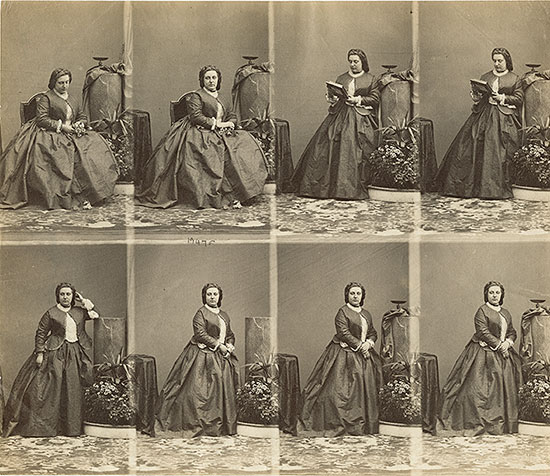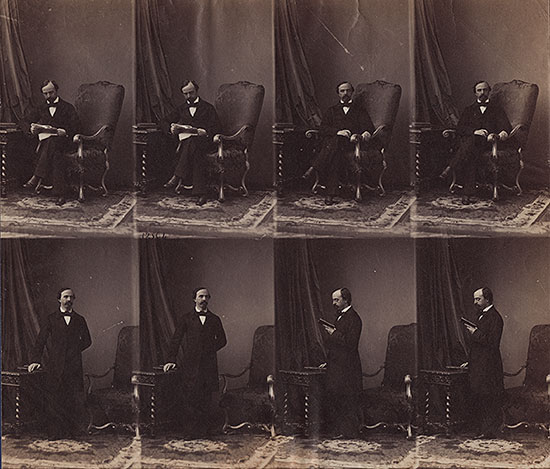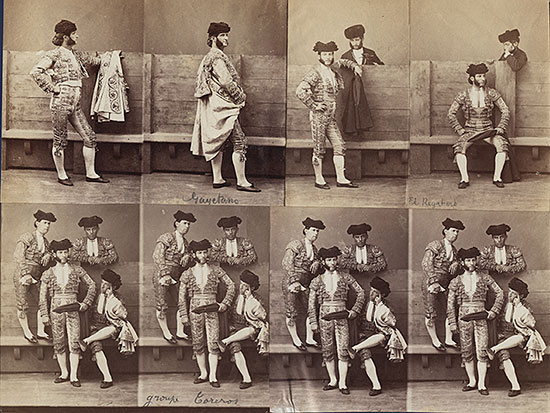The piece of the month of April 2018
CARTE DE VISITE PLATES BY EUGÈNE DISDÉRI (1819-1889)
Ignacio Miguéliz Valcarlos
UNED Pamplona
In 1850 Louis Desiré Blanquart Evrard (1802-1872) developed the albumen paper process, which made it possible to obtain positive copies on paper support, and which was the first technique in the history of photography that incorporated an emulsion. In 1854, French photographer Eugène Disdéri (1819-1889) introduced the carte de visite card de visit, a new format that focused on studio portraits. This typology consisted in the use of a camera with a pair issue lenses, always between four and eight, which could be operated all in the same shot or independently at the photographer's will, and a plate divided into two halves, with which eight images were obtained in a single plate, which greatly reduced the costs of photography, favoring its popularization and its diffusion at all levels. Due to the fragility and low grammage of the paper on which these images were printed, they were cut and pasted on small cardboards of approximately 9 x cm, the so-called 'secondary support', obtaining an individual photograph, of reduced and standardized format. The back of this support was also used to inscribe in a more or less artistic way the name of the photographic studio, as well as its address, specialties, technical data , etc.
The popularity of the carte de visite and its strong development led to the emergence of a series of variants such as the carte de colibri, cabinet, boudoir, salon, promenade or imperial, which followed the same outline and functionality but in a different format. In the case of those models of larger size than the carte de visite, they provided more information and in a clearer way than the latter, especially with regard to the identification of the character represented, making possible the physical and psychological approach to the portrayed. But at the same time, being a standardized format, they still maintained the low cost of the carte de visite, being therefore affordable for a wide social spectrum of the population. One of the functions of these photographs was to be able to submit to relatives and relatives own portrait, since these were collected, including in the family funds images of illustrious characters, members of royalty and aristocracy, politicians, military, religious, bullfighters, singers, actors, etc.. All these cards could be kept in albums, also created specifically for them, which ranged from the simplest invoice to those made with beautiful and expensive bindings, which depended on the purchasing power of the owner. These albums could alternate between the different carte formats available for sale or insert only one size.
Portraits obtained thanks to this method soon became one of the main businesses of the different photographic programs of study , which, in line with the new demand, began to equip themselves with the necessary materials for the production of these photographs. Thus, the simplest portraits consisted of bust images of the person in question, usually in a slightly tilted position, cropped on a neutral surface, and with the outlines blurred as a means of transition between the background and the figure's resounding Issue . Meanwhile, the more elaborate, full-bodied ones, were completed with a series of complicated scenographies that contextualized the portrayed figure. This atrezzo included a varied cast of pieces of furniture, architectural elements, plants, decorative objects, etc. All this was arranged accompanying the sitter against a backdrop or forillo that could be neutral or represent urban and natural landscapes, gardens, palace interiors, etc. These portraits would end up standardizing their forms of representation, the composition of their motifs, and the hierarchy and status of the person represented, just as had happened in painting, from which photography initially copied the models and forms of representation.
The images obtained from each plate could be identical or different, depending on the issue of lenses that were open in each shot, and this is what we observe in the uncut plates preserved in the collection of the Museo Universidad de Navarra, which at the same time show us the popularization that photography reached with this procedure. It is a small collection in issue but of great interest, given that it is not usual to preserve the plate with the uncropped photographs, and above all, that almost all of them belong to the record albums of Disdéri's own studio. Thus, we can see how the lenses alternate in their aperture, opening one at a time, in shots of two, or in shots of three, obtaining different photographs, although very similar to each other. Thus, several plates with portraits of the Bourbon family are preserved, dated around 1859-1860, among which the portraits of Queen María Cristina de Borbón Dos Sicilias (1806-1876), second wife of Ferdinand VII, stand out, in two of whose photographs she is portrayed with her daughter María Cristina Muñoz y Borbón (1840-1921), Marquise of the Isabela; of María Amparo Muñoz y Borbón (1834-1864), Duchess of Vista Alegre and Countess Czartoryska, eldest daughter of the aforementioned queen; Infanta María Josefa de Borbón (1827-1910), sister of King consort Francisco de Asís; Princess Victoria de Borbón Dos Sicilias (1838-1895), Countess Mascali, niece of Queen María Cristina; of Luis de Borbón-Dos Sicilias (1824-1897), Count of Aquila, brother of Queen María Cristina; and of Carlos de Borbón y Braganza (1818-1861), Count of Montemolín, Carlist pretender to the Spanish throne as Carlos VI. Images that represent these characters in a private way, in intimate portraits far from the courtly representations more in line with painting or with more expensive techniques, aware of the possibility that the carte de visite offered them to portray themselves in different times and situations, as we can also see in the plate with the portrait of a woman in disguise. And next to these we see a plate with several bullfighters, which indicates the popularization of these pieces and the access of all social classes to the photographic medium, as well as the reflection of the taste of the moment for a topic so traditional Spanish, romantic and exotic at the same time.

María Cristina de Borbón Dos Sicilias (1806-1876) and María Cristina Muñoz y Borbón (1840-1921), Marquise de la Isabela. Plate of carte de visite. Albumen paper. 1860.

María Amparo Muñoz y Borbón (1834-1864), Duchess of Vista Alegre and Countess Czartoryska. Plate of carte de visite. Albumen paper. 1859.

Infanta María Josefa de Borbón y Borbón Dos Sicilias (1827-1910). Plate of carte de visite. Albumen paper. 1860.

Victoria de Borbón y Smyth (1838-1895), Countess Mascali. Plate of carte de visite. Albumen paper. 1860.

Luis de Borbón-Dos Sicilias y Borbón (1824-1897), Count of Aquila. Plate of carte de visite. Albumen paper. 1860.

Carlos de Borbón y Braganza (1818-1861), Count of Montemolín. Plate of carte de visite. Albumen paper. 1860.

Female portrait. Plate of carte de visite. Albumen paper. 1860.

group of bullfighters. Plate of carte de visite. Albumen paper. 1860.
bibliography
DARRAH, W. C. Cartes de visite in nineteenth century photography, Gettysburg, W. C. Darrah Publisher, 1981.
NARANJO, J., "Lasa tarjetas de visit. Del retrato privado a la imagen pública", in BALSELLS, D., LEVENFELD, R., and VALLHONRAT, V., De París a Cádiz. Calotype and Collodion, MNAC and Fondo Fotográfico Universidad de Navarra, Barcelona, 2004, pp. 188-197.
RIEGO, B., La construcción social de la realidad a través de la fotografía y el grabado informativo en la España del siglo XIX, Santander, Universidad de Cantabria, 2001.
ZELICH, C., guide de técnicas fotográficas del siglo XIX, Madrid, Photovision, 1995.
